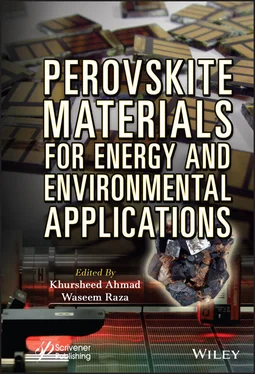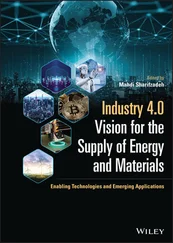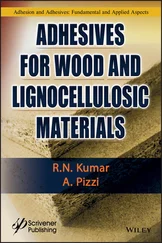Perovskite Materials for Energy and Environmental Applications
Здесь есть возможность читать онлайн «Perovskite Materials for Energy and Environmental Applications» — ознакомительный отрывок электронной книги совершенно бесплатно, а после прочтения отрывка купить полную версию. В некоторых случаях можно слушать аудио, скачать через торрент в формате fb2 и присутствует краткое содержание. Жанр: unrecognised, на английском языке. Описание произведения, (предисловие) а так же отзывы посетителей доступны на портале библиотеки ЛибКат.
- Название:Perovskite Materials for Energy and Environmental Applications
- Автор:
- Жанр:
- Год:неизвестен
- ISBN:нет данных
- Рейтинг книги:5 / 5. Голосов: 1
-
Избранное:Добавить в избранное
- Отзывы:
-
Ваша оценка:
- 100
- 1
- 2
- 3
- 4
- 5
Perovskite Materials for Energy and Environmental Applications: краткое содержание, описание и аннотация
Предлагаем к чтению аннотацию, описание, краткое содержание или предисловие (зависит от того, что написал сам автор книги «Perovskite Materials for Energy and Environmental Applications»). Если вы не нашли необходимую информацию о книге — напишите в комментариях, мы постараемся отыскать её.
The book provides a state-of-the-art summary and discussion about the recent progress in the development and engineering of perovskite solar cells materials along with the future directions it might take.
Audience
Perovskite Materials for Energy and Environmental Applications — читать онлайн ознакомительный отрывок
Ниже представлен текст книги, разбитый по страницам. Система сохранения места последней прочитанной страницы, позволяет с удобством читать онлайн бесплатно книгу «Perovskite Materials for Energy and Environmental Applications», без необходимости каждый раз заново искать на чём Вы остановились. Поставьте закладку, и сможете в любой момент перейти на страницу, на которой закончили чтение.
Интервал:
Закладка:
External users can implement new characterization approaches and new numerical segments (open-source on request). To date, these numerical modules have been established: (a) modules for front contact: metal/ semiconductor Schottky- or Schottky-Bardeen- or metal/insulator/semiconductor contact; (b) modules for interface: no interface or drift diffusion or thermionic emission semiconductor/semiconductor heterojunction interface; (c) modules for bulk layer: arbitrary layer (standard) or layer of crystalline silicon; (d) modules for optical layer: Lambert-Beer absorption or coherent/incoherent multiple reflection.
A suitable series of semiconducting layers and interfaces must be specified before measurement. For example, the properties of the semiconductor, viz. the thin film emitter a-Si:H(n) and the silicon wafer c-Si(p), should be specified. Therefore, the defect state distribution (DOS) must be defined for each layer and interfaces if appropriate. In particular, the boundary contacts must be specified: the TCO surface has been demonstrated as an optical layer for the chosen example (requiring the reflectivity and absorption measured). The contact with TCO/a-Si:H is supposed to be a depleted Schottky contact, whereas the contact’s calculated barrier height represents an input parameter. The metallic c-Si(p)/Al back contact is supposed to be a flat band with a recombination speed of 10 7cm/s for simplicity.
Once the external cell parameters (temperature, illumination, and cell voltage or cell current) have been specified, the internal cell results, such as local rates of recombination, densities of carrier, currents, band energies, and so on, can be computed both under steady-state conditions (DC) or by arbitrarily changing external cell parameters using small additional sinusoidal perturbations, and the ratio of amplitude of all these quantities can be observed.
Variation in input parameter and output parameter to monitor can be specified.
In addition, characterization procedures (measurements) can be simulated by changing external variables, as in a specific experimentation and by doing certain postprocessing analysis of the data with the results of internal cells. The following methods of measurement have been used so far: methods of DC-mode characterization: I-V, SPV, QE, PEL, ASSPC, C-V, C-f, C-T; methods of TR-mode characterization: TR-PEL, TR-SPV, intTR-PEL, TR-PC. External users can insert or implement other characterization methods (open-source on request) [24–26].
The resulting total cell current (I-V) can be calculated by variation in the voltage of the external cell at a specified value of illumination. The number of photons emitted because of band-to-band radiative recombination can be computed using the generalized Planck equation from the quasi-Fermi energy splitting within the cell.
ZnO/a-Si:H(n)/c-Si(p)/Al heterojunction silicon solar cells’ solar cell performance is critically dependent on the D itinterface state density a-Si:H/c-Si. A D it= 10 12cm −2state density at interface lowers the solar cell’s open-circuit voltage by more than 100 mV. Open-circuit photoluminescence is a quick and nondestructive characterization method susceptible to D itand needs no contact. The photoluminescence signal is quenched by a growing recombination at interface because of a higher D it.
Using complex numbers, small values of additional sinusoidal disturbances of the external parameters of the cell are treated. The shift in phase and the ratio of the amplitude between the AC cell voltage and the AC cell current can be computed as dependent on the frequency of perturbation if a small additional sinusoidal (AC) external signal voltage is superimposed on the DC voltage of the cell. The device conductance G(ω)/capacitance C(ω) at the specified frequency ω may be determined from the real/imaginary parts of the AC cell current:

When conducted under open-circuit situations, the impedance of a ZnO/a-Si:H(n)/c-Si(p)/Al heterojunction silicon solar cell is quite susceptible to the interface state density D it. For larger D it, 10 10cm −2≤ D it≤ 10 12cm −2, the resonant frequency (maximum of the phase shift) shifts toward higher frequencies. On the other hand, if operated under dark or short-circuit conditions, the D itsensitivity is low: for instance, the conductance depending on the temperature in the dark changes only for D it≥10 12cm −2which is related to a change of the band bending at the equilibrium.
Because of a random shift in external parameters, the system’s time response may be determined by using a transient. “.ttd” file detailing the variations, for example, it may simulate the increase and decline of the SPV signal or the spectral integrated PL signal because of a short monochromatic laser pulse.
If ZnO/a-Si:H(n)/c-Si(p)/Al silicon heterojunction solar cells are excited by a monochromatic laser pulse at a wavelength of 900 nm, the generation of extra carriers occurs only in the c-Si(p) wafer. Hence, the recombination of the a-Si:H/c-Si interface may be efficiently tested. The SPV signal essentially tracks the shift in band bending at the surface because of excessive generation/recombination of carrier, whereas the PL signal is straight linked to excess generation/recombination of carrier. When laser pulse of 10 ns is used, all signals during the pulse do not enter conditions of steady state. Nevertheless, the two signals’ degeneration behavior occur in different time domains. It is inside the range of ms for decay of SPV and within the range of 100 ns for decay of PL. The density of states at a-Si:H/c-Si interface, D itcritically relies not only on the early values immediately after the pulse but also on the transient decay.
Until now, the AFORS-HET software has been primarily used to (1) determine total achievable amorphous/crystalline solar cells efficiencies, (2) create criteria for designing for such solar cells, (3) establish calculation approaches for controlling a-Si:H/c-Si recombination interface.
1.6 Solar Cell Capacitance Simulator (SCAPS)
SCAPS is a one-dimensional program for simulation of solar cells established at the University of Ghent’s Department of Electronics and Information Systems (ELIS). It analyzes the behavior and characteristics of solar cell structures numerically. Various measurements of the output parameters of solar cells could be performed by SCAPS. It can calculate the open circuit voltage (V oc), the short circuit current (J sc), the output characteristic J-V, the fill factor (FF), the quantum efficiency (QE), the output efficiency of the cell, the generation and recombination profiles, and so on [27–30].
Similar to any other numerical simulation program, SCAPS solves the elementary equations for semiconductors: the Poisson equation, which relate the charge and the electrostatic potential ψ , as well as the electron and hole continuity equations. The maximum length of the cell L is split into N intervals in one direction, and the magnitude of ψi and the concentrations of electron and hole ni and pi in each interval are the unknown variables of the problem. These may be identified by solution of nonlinear 3N equations numerically, i.e., the elementary equations at each of the i intervals. Additionally, instead of ( ψi, ni, pi ), one can choose ψ i, E Fni, and E Fpias independent variables. Here, for electrons and holes, E Fnand E Fpare the quasi-Fermi energy levels. As the continuity equations include a nonlinear term for recombination in n and p, the basic equations become nonlinear [31–35].
Читать дальшеИнтервал:
Закладка:
Похожие книги на «Perovskite Materials for Energy and Environmental Applications»
Представляем Вашему вниманию похожие книги на «Perovskite Materials for Energy and Environmental Applications» списком для выбора. Мы отобрали схожую по названию и смыслу литературу в надежде предоставить читателям больше вариантов отыскать новые, интересные, ещё непрочитанные произведения.
Обсуждение, отзывы о книге «Perovskite Materials for Energy and Environmental Applications» и просто собственные мнения читателей. Оставьте ваши комментарии, напишите, что Вы думаете о произведении, его смысле или главных героях. Укажите что конкретно понравилось, а что нет, и почему Вы так считаете.












